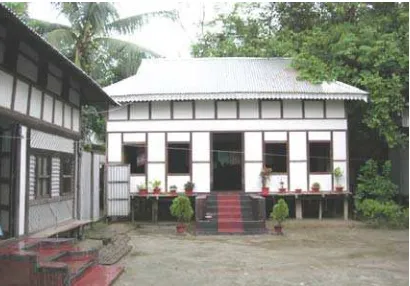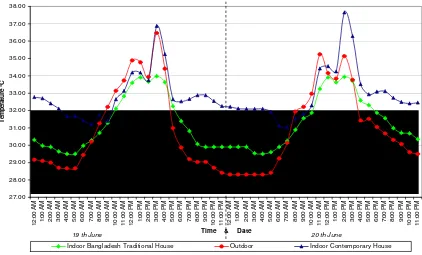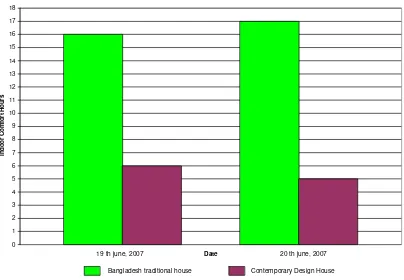THERMAL PERFORMANCE OF CONTEMPORARY HOUSE IN THE
CITY OF DHAKA
Rumana Rashid
Department of Architecture, Faculty of Built Environment Universiti Teknologi Malaysia (UTM), Malaysia
E-mail: [email protected]
Mohd. Hamdan Bin Ahmad
Institute Sultan Iskandar of Urban Habitat and Highrise Universiti Teknologi Malaysia (UTM), Malaysia
E-mail: [email protected]
ABSTRACT
A contemporary house located within a dense area of Dhaka, the capital city of Bangladesh was selected to evaluate its thermal performance. The study was based on the field measurements conducted during selected days in the summer period. The field survey was conducted using one set of thermal data logger installed in the selected house to record the air temperature and relative humidity of both indoor and outdoor spaces. The research result concluded that the contemporary house experienced much higher temperature during night and early morning. The indoor air temperature during the daytime was equal to the outdoor or sometime higher illustrating that it was overheating. On the other hand, previous study on traditional house within the same area showed that indoor air temperature was lower than outdoor air temperature, something that the contemporary house failed to achieve.
Keywords: Contemporary House, Thermal Performance, Indoor Environment, Thermal Comfort
INTRODUCTION
Dhaka city is now accommodating nearly 6 million people on an area of 815 square kilometers (Population Census 2006). The figures illustrate density of about 8251 persons per square kilometer. Housing in Dhaka is in developing stage now where contemporary design is fast replacing traditional one. However, many feel that the contemporary house design is unsuitable to climate of Dhaka. User response often point to inadequate climatic performance and perceived waste of space (Rashid, 1991; Ahmed, 1990).
Traditional houses in Bangladesh are influenced by the local available materials, climate depended and economic ability of the people (Rumana, 2007). Thermal performance study of the Bangladesh traditional house shows that the indoor environment is comfortable during both summer and winter period (Rumana and Mohd Hamdan 2007). On the other hand, contemporary designed houses are characterless, thermally inefficient and expensive to run and they are now rapidly replacing the traditional houses built in cool, lightweight, renewable materials and largely built by sweat equity (Kevin, 2006).
AIMS AND OBJECTIVE
This study on a selected single storey reinforced cement concrete (R.C.C) post and beam structural system contemporary house in Dhaka is used to illustrate the typical resultant indoor thermal environment. The aim of the study is to investigate the thermal performance of contemporary house design in Bangladesh within the City of Dhaka during summer season. The objective is to illustrate the resultant thermal performance of the contemporary house and indirectly inform the contemporary designer to be aware of the unsuitability of the typical modern solution in providing good thermal comfort environment.
BACKGROUND STUDY
Climate of Bangladesh and the City of Dhaka
Bangladesh lies between 20º 34′ N to 26º 33′ N
and 88º 01′ E to 92º 41′ E, and is in the
Generally the climate has short and dry winter while the summer is long and wet. Although a large part of the country’s land mass lie above the Tropic of Cancer, the nature of the climate being tropical is attributed to the regional geographical character. The Himalayan mountain range and Tibet Plateau being in the north causes a significant amount of rainfall (Hossain and Nooruddin, 1993; Rashid, 1991). The humidity is fairly high throughout the year and especially during the months of June to September when it is often over 80%. Annual
maximum temperature is 34.5°C in summer season
and minimum is 12.7°C during winter season.
Description of the Selected Contemporary Houses
The contemporary house construction system in Bangladesh has brick wall structure and reinforce cement concrete (R.C.C) post and beam structure. Brick wall load bearing structure has its limitation. The highest possible structure is up to five floors with limited size of opening allowed, but not suitable for flood and risky during earthquake. On the other hand, R.C.C post and beam structure has no limitation in construction and easy to construct. For this reason, concrete post and beam type of contemporary house design is most popular and being built in all regions of Bangladesh thus influenced the selection of this type of contemporary house in this study.
Figure 1 shows the selected contemporary house constructed with R.C.C structure and floor, brick walls with plaster, and reinforced cement concrete roof slab (150mm thickness) without any type of insulation.
Figure 1. Typical Contemporary Design House in Bangladesh.
The windows are single glazed. This is considered typical of contemporary house design being built in all regions of Bangladesh. In comparison figure 2 illustrates typical traditional house raised on timber stilts. While figure 3 shows the close proximity between the two types of houses within highly dense area of the city.
Figure 2. TypicalBangladesh Traditional House.
C.D.H
B.D.H
Figure 3. Physical position of the Bangladesh Traditional House (B.D.H) and the Contemporary Design House (C.D.H).
METHODOLOGY
This research is developed through a practical field measurement of the selected contemporary house in Dhaka, Bangladesh. The resultant indoor thermal environment is compared with measured outdoor condition. The survey was conducted using thermal data logger (HOBO Data Logger). Figure 4 illustrates the installation of the data loggers.
of the third (3rd) June to the twenty-fifth (25th) June in the year of 2007.
The comparative thermal performance evaluation was made on the basis of the air temperature difference between contemporary house and the outdoor ambient air temperature.
According to research conducted by Mallick (1994), air temperature for comfort without air movement and for people wearing normal summer clothing engaged in normal household activity indoors were within the range of 24 ºC and 32 °C. Further, he suggested that the relative humidity
Figure 4. Section of typical contemporary designed house and the position of data logger and sensor.
27.00
Indoor Bangladesh Traditional House Outdoor Indoor Contemporary House
19 th June 20 th June
should be from 50% to 95%. In still air condition, people would feel comfortable even in higher humidity, which is an expected response in a location like Dhaka where humidity is generally high for most of the year.
RESULT S AND FINDING
Temperature in the contemporary house is high especially during the day and the heat is retained at night resulting in high temperature above the outside air temperature (Figure 5). Therefore, if there is no mechanical means of controlling the internal environment, the contemporary house will not be able to achieve the appropriate thermal comfort suggested by Mallick (1994). If we compare to the result of the measurement in traditional house (using previous data from Rumana, 2008) the traditional house perform much better (see also figure 5). This is probably due to the higher passive cross ventilation rate indoor, assisted by wooden elevated floor, use of tall lightweight materials with low time lag and well-ventilated double layer roof section (or attic) which protect the indoor space from the direct solar radiation.
From the result of measurement, it can also be noted that thermally, the contemporary house is always hotter throughout the day than the traditional house. Scatter diagram (figure 6) for contemporary house shows that only 20% of the scattered points are inside the comfort zone.
0
19 th june, 2007 20 th june, 2007 Bangladesh traditional house Contemporary Design House
Figure 7. Profile of Indoor comfort hours in both B.T.H and C.D.H within 24 hours.
The thermal performance capability was indicated by longer period of thermal comfort duration indoor. The duration for comfort in the contemporary house is shorter than the traditional house. The contemporary house is only comfortable for 5 to 6 hours (midnight and early morning) while the traditional house is comfortable for 16 to 17 hours in a day (figure 7).
CONCLUSION
It can be concluded that the Bangladesh contemporary house design is thermally inefficient and more expensive to run. It is experiencing higher temperature indoor through out the day. The use of heavy wall and R.C.C roof without any type of
23.00
40.00 45.00 50.00 55.00 60.00 65.00 70.00 75.00 80.00 85.00 90.00 95.00 100.00
Relative Humidity
insulation allowed heat gain and transmission through direct solar radiation during daytime. At night the heavy roof also takes time to release heat to night sky. Lack of proper cross ventilation also helps to store the heat in the indoor for longer period. Location within dense city of Dhaka will make the house more unbearable and that is why most contemporary houses have to rely on air conditioning system for achieving thermal comfort. On the other hand, the traditional houses built in cool, lightweight, renewable materials and largely built by sweat equity have better thermal performance. It is hoped that modern house designers can adopt and learn from the traditional house design and its environmental features in order to have better response to the harsher summer condition of Dhaka city and by so doing provide good thermal comfort to the occupant.
Acknowledgement
In the name of Allah, the most Gracious, the most Merciful, for giving me the determination and will to complete this study. We would like to say thanks to Universiti Teknologi Malaysia and also special thanks to Rokon from AUST and Shamima from FE&A Ltd. Bangladesh.
REFERENCE
Ahmed, K.I. (1990) The Ministers’ Hostels.
Unpublished Term Paper. Massachusetts Institute of Technology, Cambridge, U.S.A.
Ashraf, K.K. (1989) Muzharul Islam, Kahn and
Architecture in Bangladesh. Mimar, no.31.
Cartney, K.M. (2006) iNTA Conference
2006-Harmony in culture and Nature.
Curtis, W. (1986) Towardes an Authentic
Regiona-lism. Mimar. No. 19.
Hossain, M.E. and Nooruddin, M. (1993) Some
Aspect of Urban Climates of Dhaka City. Proc. International Technical Conference on Tropical Urban Climates, Dhaka.
Houghton, D.D, Ed. (1985) Handbook of Applied
Meteorology. John Wily & sons. Canada.
K. Iftekhar Ahmed. (2003) “Quest for Regionalist
Architecture in Bangladesh”. Open house
international, Vol. 28. No 3. September, 2003
Koenigsberger, et al. (1973) Manual of tropical
Housing and Building Design, Part I. Orient
Longman.
Lean, G. (1990) Atlas of the Environment, Arrow
books Ltd., London.
Mallick, F.H. (1994) Thermal Comfort for Urban
Housing in Bangladesh. Ph.D. thesis
(unpublished), A.A. School of Architecture.
Population Census 2006. Bangladesh.
Rashid, H. (1991) Construction and Kahn’s capital.
Mimar, no. 38.
Rashid, Haroun. Er. (1991) Geography of
Bangladesh. 2nd Ed. The University Press ltd. Dhaka, Bangladesh.
Rumana, R. (2007) Traditional House of
Bangladesh: Typology of House According to
Material and Location. Virtual Conference on
Sustainable Architectural Design and Urban
Planning, Asia Sustainability Net.upc.edu.. 15th
-24th. September 2007.
Rumana R., Mohd. H. Bin Ahmad, (2007) Thermal
performance by the Traditional Roof Section in
Bangladesh. 8th Senvar & 2nd Malay
Architecture Conference. Sustainability in
Rain, Sun and Wind, 23rd-24th. August. 2007.
Surabaya. Indonesia.
Zahiruddin S.A. et al, (1990) Contemporary


